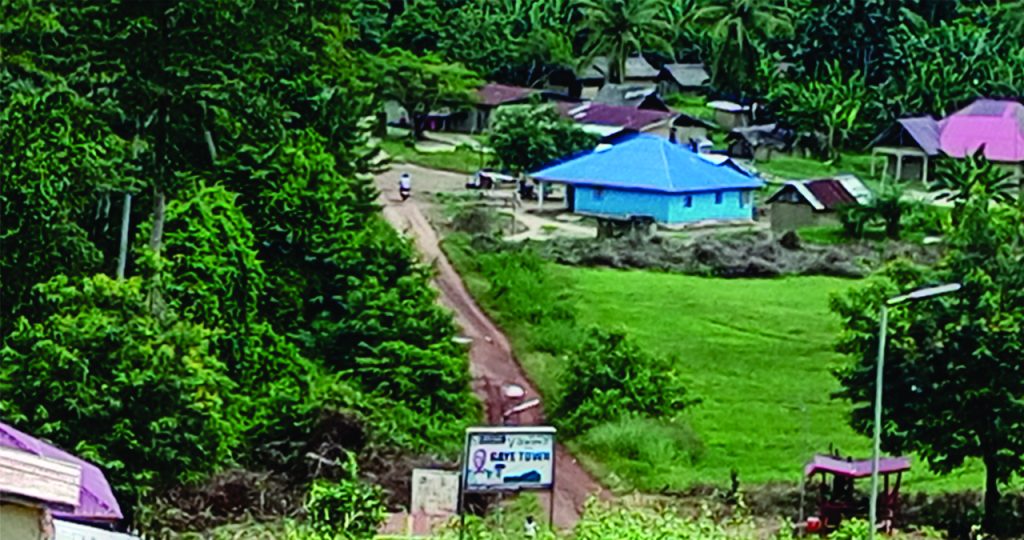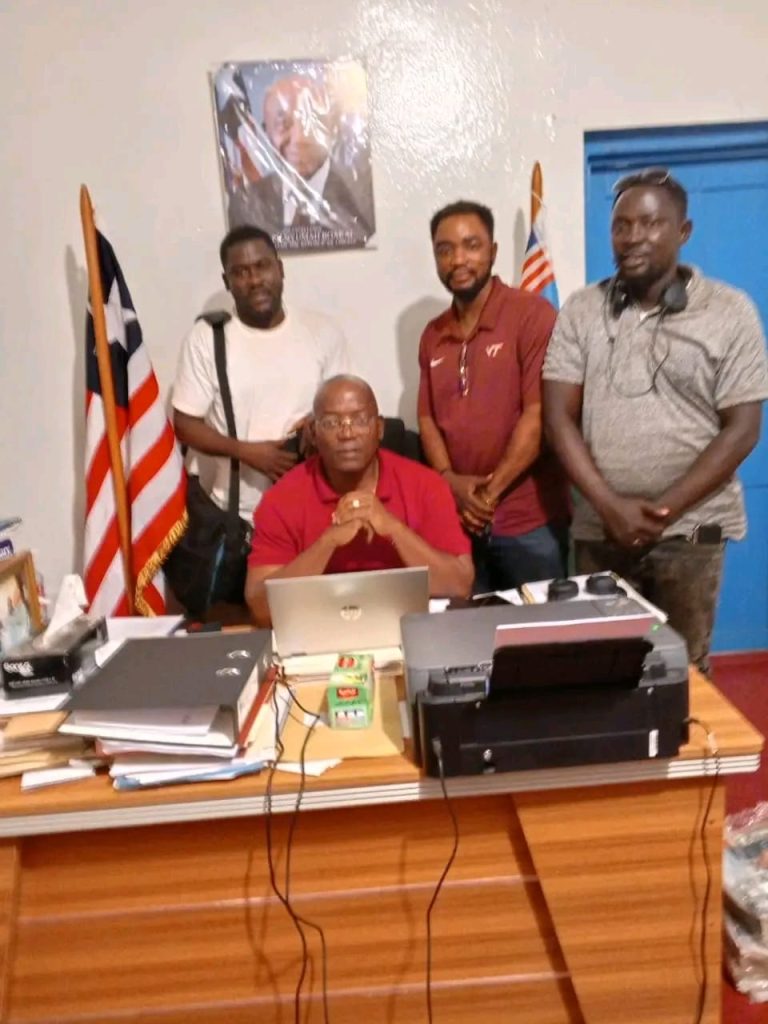Top: FDA Managing Director Rudolph Merab in a group photo with residents of the Proposed Kwa National Park, Gbarzon District, Grand Gedeh County. Gaye Town-Thursday, November 13, 2025. The DayLight/Varney Kamara
By Varney Kamara
GAYE TOWN, Grand Gedeh – The Forestry Development Authority (FDA) recently announced a resurvey of the Grand Gedeh portion of the Proposed Kwa Protected Area within 90 days. The FDA ordered farmers to halt further degradation of the park, warning of punitive actions.
“We will cut the boundaries and ensure that the government collects what belongs to it, and then the community will get its benefit,” Merab said in a meeting with community representatives in Gaye Town, which borders the park. “I don’t want to see anybody planting cocoa or doing farming business in there.”
But Merab left out important information about the FDA’s plan after the resurvey. A document The DayLight obtained shows that the FDA targets a potential auction of the area where cocoa has been planted. The document was written on October 10, about a month before the Gaye Town meeting.
The document also shows that an unnamed FDA manager dissented from the regulator’s plan to seize and auction. The manager wrote that the “bad precedent” would undermine conservation efforts, fuel violence, and be legally misplaced.
“My technical advice is straight implementation of the law – establish boundaries at the jointly agreed areas and make the presence of the forest rangers,” wrote the unnamed manager.
A DayLight review of multiple laws and regulations confirms the manager’s dissent. While the FDA can punish encroachers, it cannot auction farmland in a proposed protected area.
Like the anonymous manager, the Wild Chimpanzee Foundation (WCF), an NGO helping to establish Kwa, opposes the seizure and auctioning plan. Clement Tweh, WCF’s Program Manager, said there was no need to seize and auction the property. He urges the FDA to remove encroachers from Kwa and identify and support livelihood programs for communities.
Tweh also disagrees with the FDA over the resurvey idea, warning the exercise would cause more harm than good.
“This will lead to more problems because lines were drawn during previous surveys. Potential conflict spots were duly identified and demarcated. I don’t see the need for another one,” Tweh said.
“All the FDA needs to do is to remove the park’s illegal occupants, and identify and support alternative livelihood activities for communities.”
The FDA insists on the resurvey. Asked whether the FDA would replicate this action in other proposed and protected areas since encroachment was commonplace, Merab nodded, depending on a “positive” outcome of Kwa’s resurvey.
“We are here because our people keep complaining about encroachment and conflict all around here. Our action is intended to resolve all these issues,” Merab told The DayLight on the margins of the Gaye Town meeting.
Kwa crosscuts River Cess, Sinoe, and Grand Gedeh Counties. It protects Liberia’s vital biodiversity within the Upper Guinean forests, West Africa’s largest remaining rainforests. With 90 percent of its primary forest intact, Kwa hosts vulnerable wildlife species such as the Western chimpanzee, pigmy hippopotamus, and slender-snouted crocodile.
Protecting Kwa is vital for Liberia’s commitment to conserve 30 percent of its rainforests, conservationists say. It contributes to the country’s climate commitment to cut deforestation and forest-related emissions by 2030.
It would be the third time that Kwa has been surveyed.

Kwa, formerly known as the Krahn-Bassa Proposed Protected Forest, was first surveyed between 1950 and 1952 as part of a general survey of the Kwa National Forests, a fulfillment of the Act for the Conservation of Forests, which established legal frameworks for National Parks and protected areas.
In 2023, a survey found that Kwa measured 236,246 hectares after feasibility studies and community consultation in 2016. However, it lost some 64,358 hectares to roads, encroachment, and mining, and now measures 171,888 hectares. These activities have led to habitat loss and the destruction of the ecosystem.
Conservation versus mining
The disagreements over the FDA’s resurvey come amidst miners’ interest in parts of Kwa. In July and August, Grand Gedeh Superintendent Alex Grant met representatives of GLM Inc., an affiliate of Bea Mountain Mining Corporation, Liberia’s largest gold producer.
Pictures The DayLight obtained show Grant, Timothy Amos, a GLM official, and another man in a group picture with Grant in his Zwedru office. They disclosed plans to extend their operations to Boe Geewon, Grand Gedeh’s portion of Kwa.
“I remember some members of a Bea Mountain affiliate met me in my home office and said they wanted to do prospecting in parts of River Cess and Grand Gedeh,” said Grant, who has been under fire for an illegal cocoa farm deal covering 500 acres.
“I told them to go and bring their authorization from the Ministry of Mines and Energy. I did not authorize anyone to go mine in those places.”
Merab said he was unaware of miners’ interest in Kwa, and that nothing had been decided when the survey ended. “We will come back and sit down with our people to decide what to do when it is finished.”
GLM did not respond to queries from The DayLight. Amos had promised to return the question on Wednesday, but had not by Thursday.

Earlier this year, communities in River Cess withdrew their support for the establishment of Kwa through a petition to lawmakers, leading to the extraction of a portion of Kwa. Locals would later sign an MoU with GLM Inc., a subsidiary of Bea Mountain, which is now exploring for gold in the area.
In October, a US-based NGO, Forest Trends, published a mining report that found several licenses overlap with Kwa and other protected areas.
Mining in a proposed or protected area is illegal, under the National Forestry Reform Law, except for industrial mining, which must meet certain requirements.

